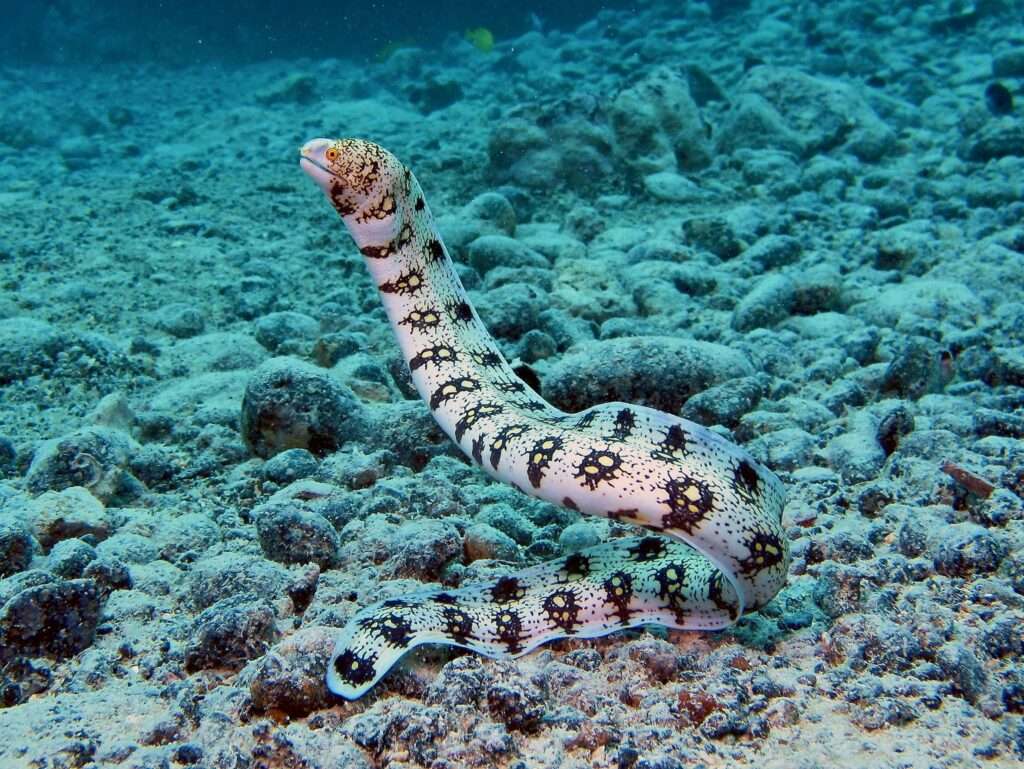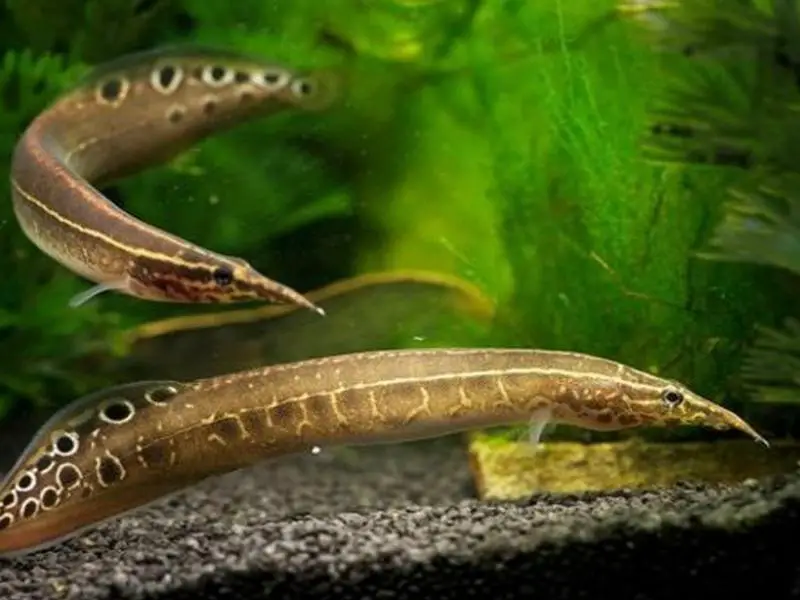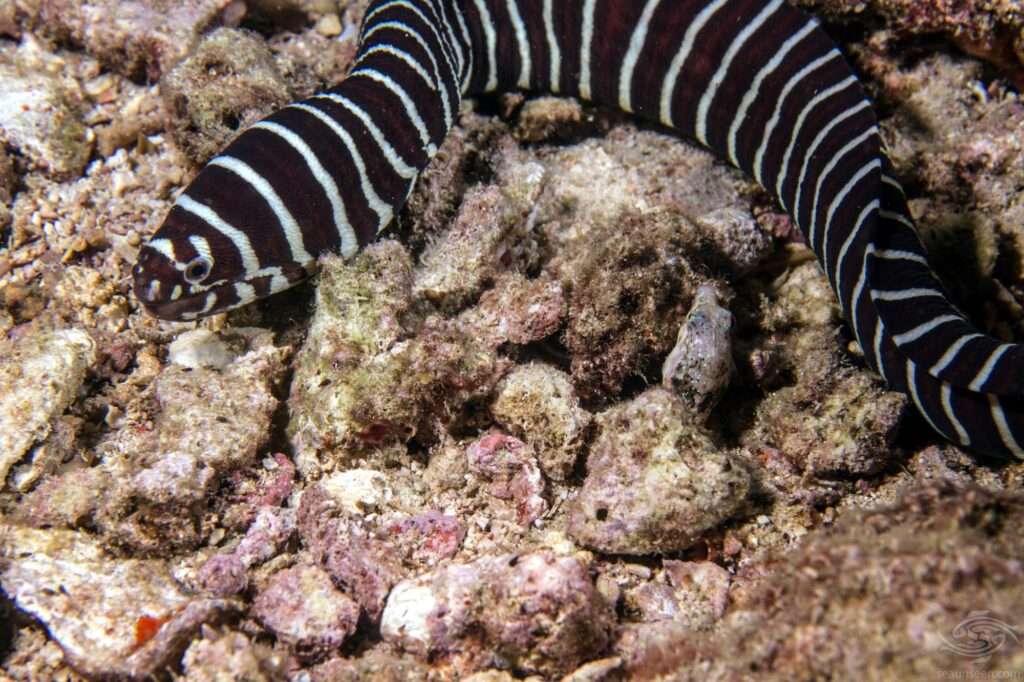
Undoubtedly one of the most well-known spiny eels is the Tire Track Eel Mastacembelus favus. This fish’s popularity is due in part to its color pattern, but it is also due to its common availability and easily comprehensible common name. It has a wide geographic range and a wide range of color patterns, however the majority of populations have the distinctive “tyre track” or “zig zag” type marks.
Despite not being regarded as real eels, all members of the Mastacembelidae family of spiny eels have eel-like body shapes. The Tire Track Eel has a large snout and an extended body. With uneven, ‘tyre track’-like markings along the length of its body from the top of its back to its belly, its background color is tan to light brown. It goes by the names Zig Zag Eel, Tiretrack Eel, and White Spotted Spinyeel.
M. favus, a favourite from Asia, is maybe the spiny eel species that is imported the most. When first acquired, often when it is between 6 and 8 inches long, this fish is a very appealing little creature. It is a hardy but reserved fish. It gets along well in a group tank but needs places to hide when it wants to withdraw. It gets along well with the other fish in its tank, until they are small enough to fit in its mouth, in which case they become food. Be advised that this spiny eel will grow while buying it. Adults will need a very large tank because it may grow to around 2 1/2 feet in length.
Habitat
Hora first identified the Track Eel Mastacembelus favus in 1924. Southeast Asia, encompassing India, Myanmar, Thailand, and the entire Malay Peninsula, is home to them. Because it is widespread and common, this species is classified as least concern (LC) on the IUCN Red List. Overfishing, pollution, and other hazards are currently regarded as unimportant. Other names for them include White Spotted Spinyeel, Zig Zag Eel, and Tiretrack Eel.
They live in waters that are moving. They frequently hide out in the gravel substrate during the day, emerging at night to feed on water invertebrates, plant materials, tiny fish, and other aquatic invertebrates.
Traits
The Tire Track Eel has an extended body and a long snout. The caudal fin is connected to the expanded dorsal and anal fins. Although some have been reported to grow up to 36 inches, these fish will only reach a maximum length of 26 inches (70 cm) (91 cm). The Zig Zag Eel Mastacembelus armatus might have been mistaken for these larger fish. Spiny eels live between 8 and 18 years. Tan to light brown is the coloring of its background. It has an irregular pattern of dark patterns along the entire length of its body, vertically from back to belly.
This fish and several other species of spiny eels have been known by the popular names “tyre track” and “zig zag” because of their distinctive patterning. This fish should not be confused with its closely related Zig Zag Eel M. armatus, which grows much larger and can reach lengths of up to 35 inches (90 cm), while having a very similar appearance. Because they seem so similar, these two are frequently confused when they are young. Despite having extremely similar outward features, they differ in noticeable ways.
The majority of their coloring is relatively similar, and each has a smattering of erratic dark patterns down the length of their bodies. However, on the Zig Zag Eel (M. armatus), the belly is largely plain and the markings are strongest on the upper two thirds. They are more pronounced irregular marks on this eel, the Track Eel M. favus, that extend from the top of its back through its belly.
Keeping as Pet

Foods
The Tire Track Eels are omnivorous in the wild. They consume small fish, worms, insects, and other water invertebrates at night, although they will also consume some plant matter and debris. They favour a diet of live, fresh-frozen items like brine shrimp, black worms, earthworms, or bloodworms, as do all spiny eels.
It is possible to teach some tyre track eels to consume freeze-dried brine shrimp or bloodworms, although this is not always successful. Make sure their tank mates are too big to fit in their mouths because they will also consume little fish. Eels only need to be fed once every two to three weeks, and some may reject food supplied more frequently than that.
Face Difficulty to Keeping in Aquarium
Eels are typically recommended for more experienced aquarists rather than fish keepers who are just starting out. This eel can be quite sensitive to change and frequently needs some time to overcome its timidity. Getting them to eat during the first two weeks can be really challenging. They do need water that is exceptionally pure. They have very thin scales covering their bodies, making them vulnerable to parasites and fungi, as well as extremely sensitive to treatments. Copper-based treatments should be avoided because these fish do not respond well to them. These eels grow pretty large and have a long lifespan if properly cared for.
Table





